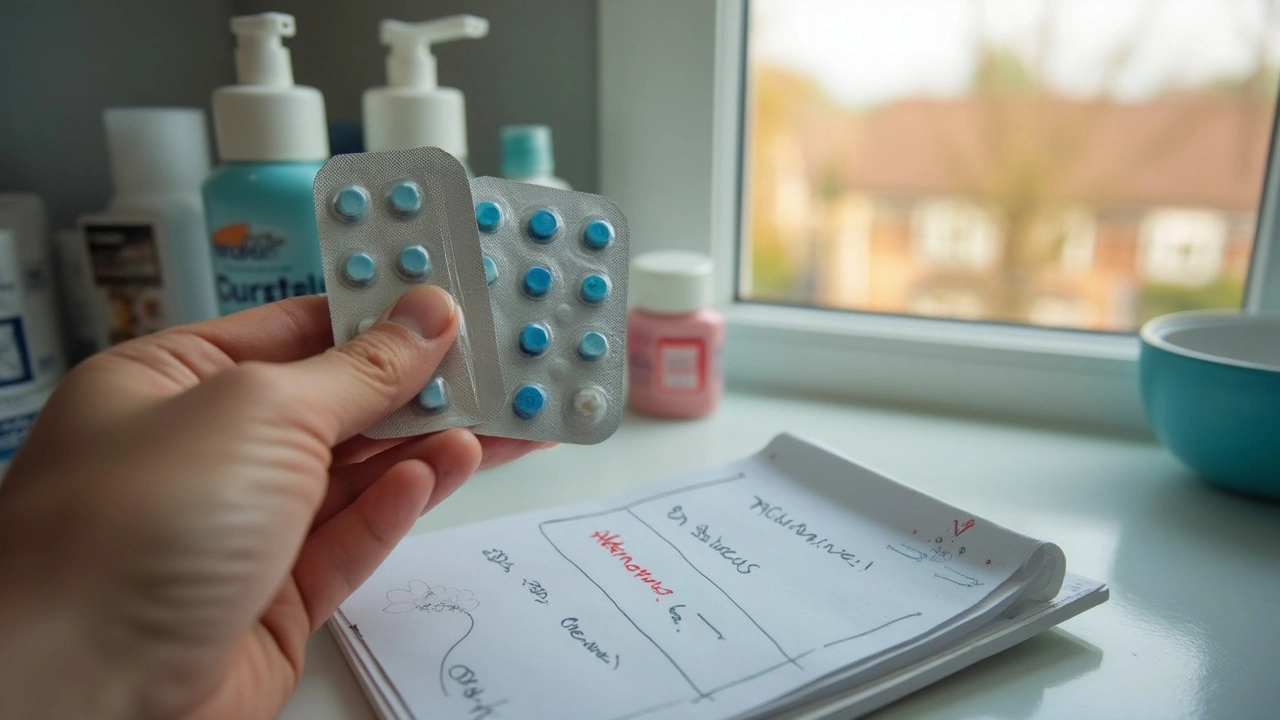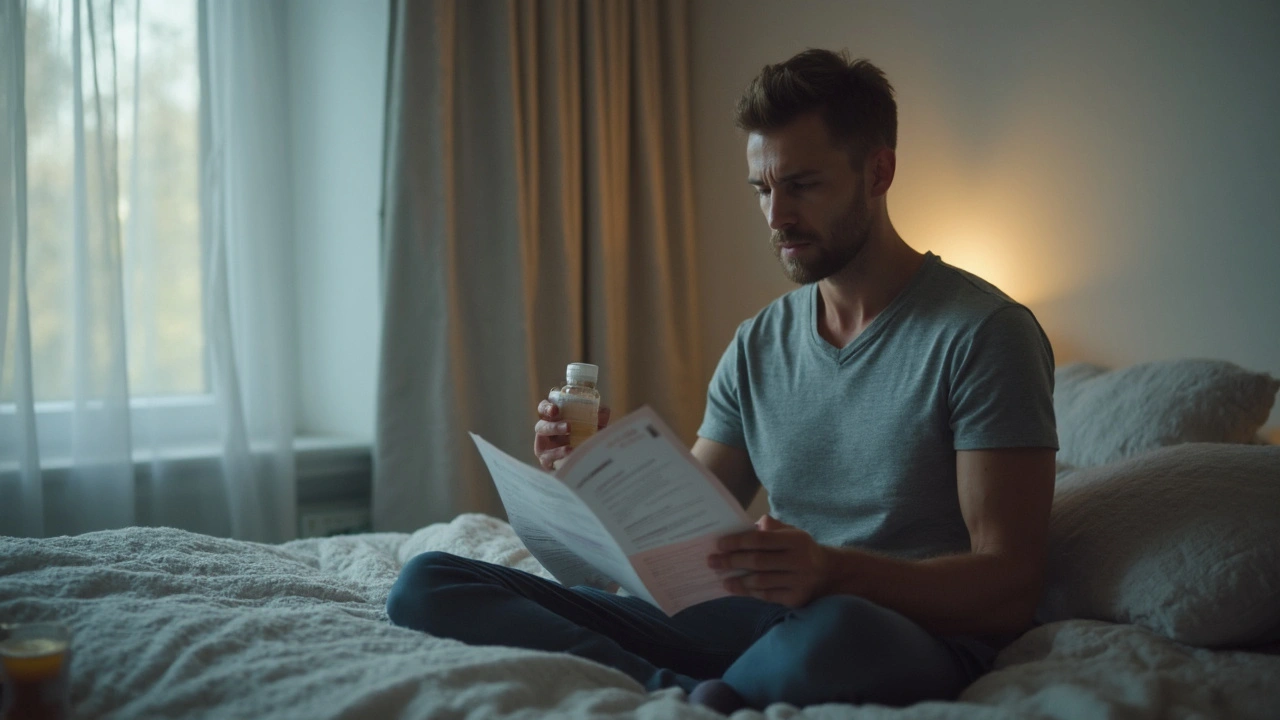Why Look Beyond Priligy?
If you’ve been dealing with premature ejaculation (PE), you might already know that Priligy (dapoxetine) is one of the go-to prescription meds. But it’s not perfect for everyone. Priligy can bring a host of side effects, isn’t cheap, and honestly, it doesn’t work for every guy. Some men feel sick, dizzy, or complain about fuzzy thinking within an hour of swallowing a pill. Others can’t stand that the results last only for a night and not for good. Money-wise, Priligy can really eat into your monthly budget since insurance rarely pays for it just because you want better sex.
So, what are guys doing instead? More are turning to legitimate Priligy alternative options, hoping for fewer side effects, better prices, or just something that works longer than a couple of hours. Let’s break down where Priligy comes up short and why you might want to look elsewhere. First, there’s evidence that the improvement in ejaculation time with Priligy only averages 1–1.5 minutes over placebo. Second, the inconsistency is frustrating. Some men take a tablet and nothing happens, others get headaches, sleep poorly, or lose their libido. A study published in the Journal of Sexual Medicine (2023) found almost a third of users stopped using Priligy within six months due to side effects or lack of efficacy.
If you want alternatives, you’re not alone. Clinics and specialists report a large uptick in guys asking specifically for newer SSRIs, non-drug strategies, or “numbing gels” (spoiler: these work differently than you’d expect). The good news? There are plenty of evidence-based options out there, whether you want a prescription, a DIY technique, or something over-the-counter. Next, I’m going deep into each proven strategy, so you can pick what fits your needs and lifestyle without just guessing at the pharmacy.
On-Demand SSRIs: What’s Different from Priligy?
Not all SSRIs (selective serotonin reuptake inhibitors) work the same in the bedroom. While Priligy is technically an SSRI, it’s fast-acting (hence “on-demand”) and gets cleared out of your system in a few hours. The idea was to give men the option of a quick fix before sex. But other SSRIs aren’t limited to just Priligy and, interestingly, some work just as well—or better when taken on-demand.
Consider sertraline, paroxetine, and fluoxetine. All are classic SSRIs mainly used for depression or anxiety, but doctors have prescribed them off-label for PE for ages. A study in the British Journal of Urology (2022) showed sertraline, taken 3–4 hours before sex, increased time to ejaculation by over two minutes on average. Better yet, the side effects are often milder than with Priligy.
Here’s a quick comparison you’ll actually find useful:
| Drug | Onset | Duration | Main Pros | Main Cons |
|---|---|---|---|---|
| Priligy (Dapoxetine) | 30-60 mins | Several hours | Specifically approved for PE; rapid action | Nausea, dizziness, cost |
| Sertraline | 2-4 hours | 1 day | Wider availability; often fewer sex side effects | Needs more planning, not FDA approved for PE |
| Paroxetine | 2-4 hours | 1 day | Can be very effective; low cost | Sexual numbness, sweating, must dose correctly |
One big upside? Sertraline and paroxetine are dirt cheap compared to Priligy. Even generic versions cost a fraction, and many insurance plans will cover them if you get a “depression” diagnosis. The biggest tip: don’t expect instant results on your first try. Your body needs to adjust, so give yourself a week or two before judging if it’s working for you. And always follow your doctor’s instructions for dosing, since taking too much SSRI at once can mess with your mood, sleep, and desire.
If prescription pills still sound like the best approach, check out a real-world list of Priligy alternative options that cover everything from pills to counseling and more unconventional solutions. You’d be surprised how many new drugs are in clinical trials right now—from faster-acting antidepressants to drugs targeting the endocannabinoid system. The future is wide open, but meanwhile, doctors already have a handful of on-demand SSRIs to recommend today. Give them a shot before you write off medications entirely.

Behavioral Therapy: More than Just “Last Longer” Tips
If the idea of lifelong pills or risky side effects gives you pause, behavioral therapy is making a serious comeback in PE treatment. Many guys hear “behavioral therapy” and picture awkward sessions talking about their feelings, but that’s not really the story. Instead, most evidence-backed therapies focus on practical skills—stuff you actually do in the bedroom to help delay climax.
The starter techniques are called the “stop-start” and “squeeze” methods. They’ve been researched for over 40 years, and recent reviews (see the 2021 International Journal of Impotence Research) still show they help about 60% of men—sometimes extending intercourse by two minutes or more. How do they actually work? When you feel yourself close to climax, you either pause all stimulation (“stop-start”), or lightly squeeze the tip of your penis for several seconds until the urge passes. Over time, the brain gets better at postponing orgasm, especially when practiced with a partner.
Another trend is cognitive behavioral therapy (CBT). This one’s more about your headspace than your technique. Studies show that many men with PE get trapped in anxiety and negative thinking loops, which just makes things worse when the pressure is on. A solid CBT program teaches skills to manage anxiety, reframe sexual performance fears, and break out of old patterns. Some therapists use apps or digital programs where you log progress and get video coaching—no in-person chit-chat with uncomfortable eye contact required.
Don’t underestimate the power of communication, either. In couples-focused therapy, both partners learn to talk more openly about sex, which studies (like the 2022 Sexologies review) show leads to better outcomes, more satisfaction, and sometimes longer sex. Even if you’re going solo, learning about body relaxation, breathing exercises, and pelvic floor exercises can stack the odds in your favor. Some men use a combination—self-help books, sex therapy video courses, and therapist sessions as needed.
Behavioral therapy might not make headlines, but it’s the only option with no physical side effects, no need for a prescription, and lifelong potential if you stick with the practice. Most guys notice some improvement within a month—faster if their partner is supportive or they commit to practicing regularly. It’s also the only approach that genuinely re-trains your body and mind, so you’re not dependent on drugs or sprays. Sure, it’s less flashy than popping a pill, but the long-term payoff is hard to ignore. If instant results matter less to you than real change, give behavioral therapy a serious try.
Topical Anesthetics: Getting Numb to Last Longer
For men who want something you can slap on right before sex, topical anesthetics are a no-fuss option. These products—mostly creams or sprays with lidocaine or prilocaine—dull the sensation on the penis, making it easier to last longer. What’s wild: the first versions of these meds date back over 50 years. Modern sprays can bump up ejaculation time by 3-6 minutes, according to a meta-analysis in Urology (2023).
The beauty here is speed and simplicity—many guys notice results the very first time. Apply a small amount to the head and shaft about 10-15 minutes before sex, wait until some numbness is felt, then wipe off any excess to avoid numbing your partner. Newer formulations, like Fortacin spray (dapoxetine-lidocaine combo), claim even faster onset and more consistent results. In some countries, you don’t even need a prescription for basic lidocaine gel or spray.
But there are downsides. Overuse can reduce pleasurable sensations a bit too much, and failing to wipe the area clean can lead to accidentally numbing your partner (awkward doesn’t even begin to cover it). Allergic reactions are rare but can happen; always test on a small skin patch first. Plus, long-term use isn’t really studied. These are designed for “as needed” use, not every single time you have sex. If you go overboard, you could end up with burning or irritation that sticks around for a few hours.
Tip: look for products specifically labeled for PE—some “numbing creams” made for other uses might contain extra additives that aren’t so penis-friendly. Stick to well-known brands, read the labels, and don’t wing it if you have sensitive skin. Most pharmacists have seen it all and can help you choose the right formula if you’re shy about asking.
- Apply the cream or spray with a single-use glove or applicator
- Wait at least 10 minutes for the effect
- Wipe off before intercourse
One unexpected upside: topical anesthetics work well for men who need instant results but don’t want the “head fog” from pills. Some couples even use them as a short-term fix while practicing behavioral skills for a longer-term solution. If you want to last longer tonight, this is as close to a sure bet as medicine offers—just use common sense and follow directions to avoid killing the mood.

Additional Alternatives and Next-Gen Options
If none of the above seem like the right fit, don’t worry—PE treatment is evolving quickly. Researchers are experimenting with a new wave of medications and non-drug gadgets, hoping to close the gap for men who don’t respond to SSRIs, therapy, or anesthetics.
One under-the-radar option? Tramadol, the painkiller. Some doctors prescribe low-dose tramadol as an off-label fix for PE, especially if standard SSRIs aren’t effective. It slows ejaculation but brings its own set of risks—possible dependency, nausea, and, in rare cases, breathing trouble. It’s definitely a “second choice” and should only be used under close medical supervision. Next, there are nutrients like zinc, magnesium, or ashwagandha. While the evidence isn’t nearly as strong as it is for SSRIs or anesthetics, guys with certain deficiencies sometimes see improvement with robust multivitamin use. Just don’t fall for miracle pill marketing—results are hit-or-miss.
Tech-based solutions are another frontier. Some clinics offer stimulation control gadgets that help retrain your orgasm reflex with subtle vibrations and tracking apps. The tech isn’t cheap, but men who like “quantified self” approaches find them useful for making steady progress. There’s also buzz around “pelvic floor exercises”—aka Kegels for men. They strengthen the muscles under your pelvis, helping with better control. Most physical therapists can teach these in a single session, and you can practice them anywhere (nobody will notice!).
PE has been linked to certain health conditions—like prostatitis or low testosterone—so don’t ignore possible medical causes. A full checkup with a urologist or men’s health expert makes sense if PE is sudden or severe. Also intriguing: certain new drugs in development, like modafinil derivatives or new serotonin modulators, may offer improvement with fewer sexual or mental side effects. As always, the choice comes down to what fits your life, your partnership, and your comfort with risk.
The PE world in 2025 looks nothing like it did even a decade ago. There’s no one-size-fits-all; your best option depends on your needs, whether you crave fast results, long-term change, or just less hassle. Don’t be shy about switching things up if the first thing you try doesn’t work. And remember, you’re in very good company—millions of modern men are figuring this out, one experiment at a time.

John K
May 1, 2025 AT 13:15AnneMarie Carroll
May 1, 2025 AT 14:14Avis Gilmer-McAlexander
May 2, 2025 AT 20:20Fay naf
May 4, 2025 AT 18:25ANTHONY SANCHEZ RAMOS
May 6, 2025 AT 07:24Matt Czyzewski
May 7, 2025 AT 21:46Laura Anderson
May 8, 2025 AT 21:34John Schmidt
May 10, 2025 AT 21:29Jerry Erot
May 11, 2025 AT 17:38